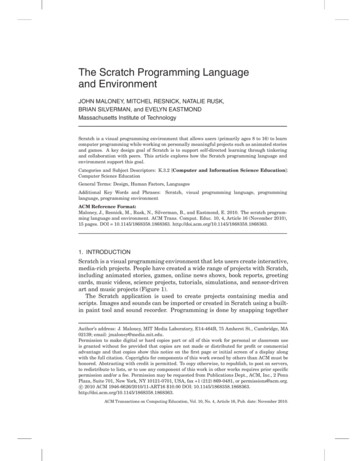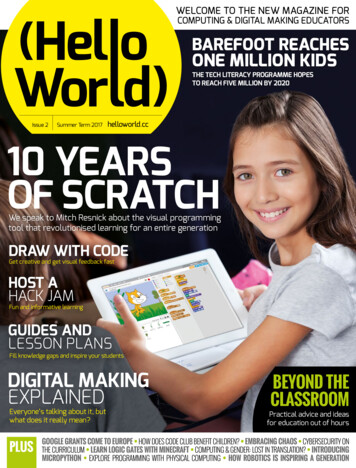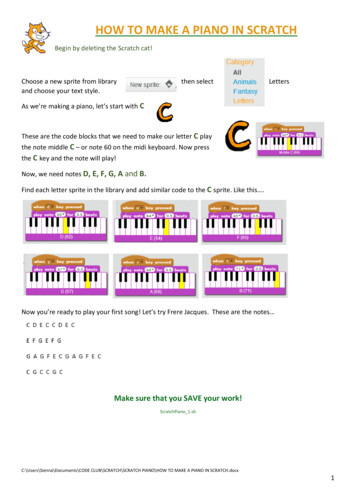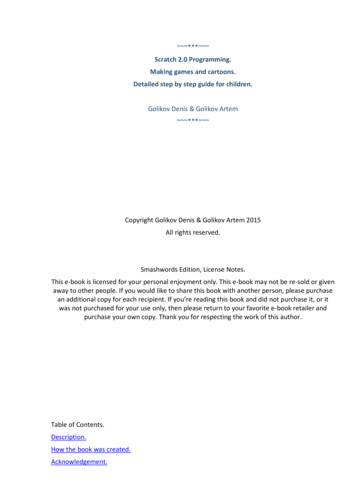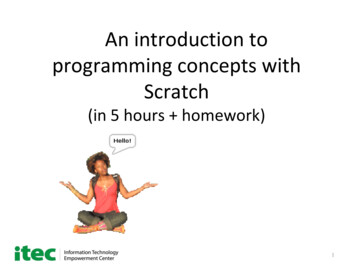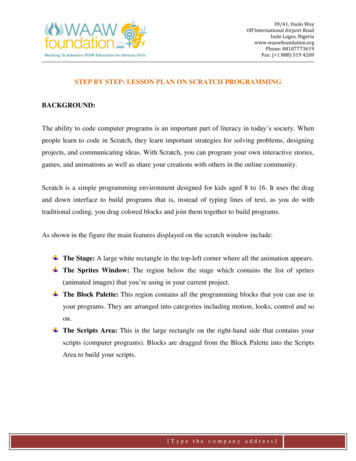
Transcription
MANUFACTURINGTRAINING:FROM SCRATCHHow to Make Workforce Training that Works
: Table of ContentsPART I: IDENTIFYING YOUR TRAINING NEEDSPART IV: IMPLEMENTATION1.Identify Business Goals and KPIs15. Review Your Materials2.Identify the Job Roles16. Do a Pilot Test3.Identify the Tasks for each Job Role17. Deliver Your Training4.Analyze Current Worker Performance of Tasks5.Analyze the Tasks6.Analyze the Employees You’ll Be TrainingPART V: EVALUATE AND REVISE18. Evaluating Employee Reaction19. Testing Employee KnowledgePART II: CREATING LEARNING OBJECTIVES AND TESTS20. Evaluating On-the-Job Behavior7.What Are Learning Objectives?21. Evaluating Business Results8.How to Create a Learning Objective9.Creating Tests (aka Assessments)10. Types of TestsPART III: CREATING YOUR TRAINING MATERIALS11. Training Theory12. Tips and Techniques13. Match Your Content to Your Training Materials14. Match Training Types to ContentWWW.CONVERGENCETRAINING.COM2
Convergence manufacturing trainingCONVERGENCEMANUFACTURINGTRAININGWe work hand-in-hand with large-scale manufacturing clients.From assembly line processes to warehouse logistics anddistribution chains, our training solutions can offer: Training Management For Manufacturing Customized Manufacturing Training Off-The-Shelf Training Mobile Training Tools Contractor Training for Manufacturing Facilities Consulting & Training Program DevelopmentLEARN MORE ABOUTOUR TRAINING OPTIONSWWW.CONVERGENCETRAINING.COM3
IntroductionINTRODUCTIONManufacturers face a series of difficult issues these days.For one, they have to compete with overseas producers whomanufacture products at lower labor costs. For another,they’ve got an aging workforce and the need to quickly“train up” new replacements that are young and bright, butinexperienced.We have customers who tell us that it has typically taken 2030 years to train a new hire to fill a high-level manufacturingjobs. Faced with the challenges above, manufacturers realizethey have to provide more effective training to condensethis training cycle. And that’s why it’s increasingly importantto turn to the proven, researched, and scientifically validtechniques of training development and instructional designwhen creating training material for manufacturing.In this guide, we provide a step-by-step method to help youdesign and create the best training materials that you can.Follow the process and tips in this guide, and you’ll be muchfurther ahead in your training development than you would ifyou proceed without a sound plan.WWW.CONVERGENCETRAINING.COM4
PART IIDENTIFYING YOUR TRAININGNEEDS
PART I: IDENTIFYING YOUR TRAINING NEEDSIDENTIFY YOUR BUSINESS GOALS & KPIsIDENTIFY YOURBUSINESS GOALS & KPIsBusiness GoalsAll job training should ultimately help your business achieveits business goals. So you should start by identifying thegoals of your business (or your department, or whateverthe appropriate business unit is). These business goals mayinclude things like: Increased profit/revenue Increased production Increased quality Improved regulatory compliance Decreased expenses Decreased waste Decreased downtime Decreased accidents, injuries, and/or incidents Decreased amount of time to train workers to fill specificrolesKPIsAnother helpful thing to do in addition to creating a listof your business goals is to identify the key performanceindicators (KPIs) used to measure them. Then you can holdthe training and later check the KPIs again. This will help youdetermine if your training had a positive effect on the KPIsand therefore your business goals.Getting Business Goals and KPIsAs a trainer, you may not always know exactly what thebusiness goals and KPIs are for the company or specificdepartments. When you’re asked to create training, askmanagers and supervisors what business goals the trainingsupports and what KPIs are used to measure those goals. Ifthey’re not certain, ask them to try to figure this out. Doingthis will give you an important tool to use when you evaluateif the training you later create and deliver was effective.As you go through the rest of the training developmentprocess, you should always ensure you’re creating trainingmaterials that will help your business achieve these goals.We will return to this idea of measuring the business effectof your training at the end of this guide, but you should alsokeep this in the back of your mind.WWW.CONVERGENCETRAINING.COM6
PART I: IDENTIFYING YOUR TRAINING NEEDSIdentify the job rolesIDENTIFY THE JOB ROLESThe next thing to do would be to identify the job roles at yourworkplace.Of course, those roles are going to depend on the type ofcompany you work for. But for an example, at a typical papermill, the list might look something like this: Machine Tender Assistant Machine Tender Back Tender 4th Hand 5th Hand Winder Operator Assistant Winder Operator Etc.It’s important to create a list of job roles for the followingreasons: Your goal is to make a worker qualified for his orher real job. This list will keep you focused so yourtraining doesn’t meander into things that aren’t actuallynecessary for the job. You will later have to determine the tasks that you haveto train workers in each job role to perform. This listprepares you for that. You will want to have an effective way of managingtraining for job transfers. Again, this will set you up nicelywhen a worker switches form one job to another. You will want to be able to create cross-training in somecases. This will help you identify the training a workerneeds for different job roles and ease the cross-traininglogistics. You will want to be able to run reports to see who’straining and not trained for various roles. Again, this willhelp you do that.WWW.CONVERGENCETRAINING.COM7
PART I: IDENTIFYING YOUR TRAINING NEEDSIdentify the tasks for each job roleIDENTIFY THE TASKS FOR EACHJOB ROLEOnce you’ve developed the list of the different job roles at your site, create alist of all the job tasks the people assigned to each job role have to perform.Let’s take a warehouse worker as an example. What are all the tasks a personin this role has to complete in order to perform his or her job? It could includetasks like these: Start and operate palletizer Drive forklift Use forklift to pick up pallets and transport them to the warehouse Place loaded pallets into warehouse storage Place loaded pallets into delivery truck Place loaded pallets into railcarTipIf it seems daunting to create a list of every task that must be performed by aworker in a given role (or in all roles), start with the major tasks. Include tasksthat are most important for production, ones that are most critical for safety,or ones that have the most expenses associated with them. Then createtraining for those and return to “fill in the gaps” with smaller tasks later.WWW.CONVERGENCETRAINING.COM8
PART I: IDENTIFYING YOUR TRAINING NEEDSAnalyze current worker performance of tasksANALYZE CURRENT WORKERPERFORMANCE OF TASKSYou’ve now got a list of the job roles at your company. In addition, you knowevery task that the workers in each job role have to perform. Eventually,you’ll want to create training materials to train workers to perform each taskassociated with every job role (although as we said earlier, you may focus onthe “key” tasks at first). And we’ll walk you through those steps of doing all thatshortly.Before you do that, it’s a good idea to evaluate the current performance ofyour workers to see if they are performing their tasks correctly. This will helpyou identify any current performance gaps between your desired or idealproduction state and your current state.You’ll do this by having someone (yourself, department managers, orwhoever’s appropriate) get out in the field and evaluate your workers’performance and the quality of your product.If everything’s great, fantastic. You’ll still need to set up your training programs(or most likely evaluate/revise them) for new hires and future transfers, butthings are looking good for now.On the other hand, if there is a gap between your ideal state and your currentstate, you’ll want to consider that issue further by doing a performanceWWW.CONVERGENCETRAINING.COM9
PART I: IDENTIFYING YOUR TRAINING NEEDSAnalyze current worker performance of tasksanalysis. We’ve explained how below.competing workplace priorities, etc. State and describe the problem with theperformance. Make sure you know exactly what iswrong or less-than-ideal. Don’t just say “they’re not doingit right.” Instead, shoot for something like this: “Workerisn’t making proper weld on corner joint.” Ask yourself: Does the performance problem reallymatter? Maybe you’ve got a performance problem butit’s not a big deal (for example, maybe training to correctit might cost more than “living with” the problem). Besure the issue merits creating a training solution. Determine if it’s a “skill gap.” Training will only solvethe problem if it’s a skill gap—meaning, there’s a skillyour employees need but they don’t currently knowhowto perform it. Make sure you’ve got a real skill gapbefore you create training. Sometimes there are otherreasons for performance problems—no incentive, Consider a non-training solution if it is a skill gap:Before you move forward to create training to close askill gap, try to identify a better solution that doesn’tinvolve training. For example, maybe redesigning thework area, automating a process, or creating a simple jobaid workers can refer to in the field can remove the needfor the skill. Develop and provide training to close the skill gap:At this point, you’d know it’s time to begin planning,developing, and implementing training. We’ve got lots oftips for you on how to do this in this guide, so stay tunedand keep reading.Click to read more information about performance analysis.WWW.CONVERGENCETRAINING.COM10
PART I: IDENTIFYING YOUR TRAINING NEEDSAnalyze the tasksANALYZE THE TASKSThe next thing to do is to perform a task analysis. During the task analysis,you’ll take a job task that you plan to create training materials for, and you’llanalyze it until you’ve created a list of the different steps a worker has toperform in order to perform the task as a whole.The point, as you may have guessed, is so that you can create trainingmaterials that teach people each step of the task.This might seem easy, and it’s not rocket science, but it can also be a littletrickier than it seems. And that’s especially true if you’re an “expert” on thetask, because there may be steps you take for granted or don’t even takenotice of anymore.Pick a Task to AnalyzeStart by picking one task associated with a job role. This is the task you’ll breakdown into its different steps or sub-tasks.Example: “Operate a Forklift.”Identify the Smaller Steps within that TaskTake that one task and break it down into a list of smaller tasks. It willprobably help to watch an expert performing the task on the job to come upwith this list. You can also talk with department managers or experiencedWWW.CONVERGENCETRAINING.COM11
PART I: IDENTIFYING YOUR TRAINING NEEDSAnalyze the tasksworkers to have them explain to you how to do this. But be careful, as these“experts” often tend to leave out steps that they take for granted. When youwrite your list, be sure to: Put them in chronological order—the first step performed on top of thelist, the last step performed on the bottom Begin them with an “action word” or “verb”—a behavior the workerperforms, like “push,” “join,” “cut,” “open,” or something similarExample: Our “Operate a forklift” task can be broken down into a series ofsmaller steps, including (but not limited to): Perform pre-inspection Start forklift Drive forklift Lift loaded pallets from palletizerCheck Your Steps Again to See if You’ve Got It RightTake a moment to review your list and see if you’ve got it right. The big thingis to make sure you’ve included the correct level of detail. In general, you’remore likely to leave out a step, but be sure you’re not going into a ridiculousamount of detail either (for example, there’s no reason to include “raise yourarm” before “push the Start button”).Keep in mind the knowledge level of the typical employee who’ll you’ll becreating this training for—that’s the level of detail you want to provide.WWW.CONVERGENCETRAINING.COM12
PART I: IDENTIFYING YOUR TRAINING NEEDSAnalyze EMPLOYEES YOU’LL BE TRAININGANALYZE EMPLOYEES YOU’LL BETRAININGBefore you develop any training, it’s also a good idea to learn more about thepeople who’ll be expected to take that training. This will allow you to createtraining materials that are most appropriate for your training audience.You might try general observations and discussions with the employees’manager(s) to find some of this information. The best way, of course, is to askthe employees themselves, either in one-on-one settings, a larger meeting, orthrough some form of questionnaire.Below is a list of some things to try to find out. Which of your job tasks do you think you know well? Which of your job tasks could you use help with? In general, what do you like about training? In general, what do you dislike about training? Which types of training do you like: classroom-style; task-basedinstructions in the work area; guided training on the job with a mentor(job shadowing or following); videos; computers and e-learning; roleplaying, simulations, and scenario-based training; written materials;WWW.CONVERGENCETRAINING.COM13
PART I: IDENTIFYING YOUR TRAINING NEEDSAnalyze EMPLOYEES YOU’LL BE TRAININGothers? What type of training do you dislike: classroom-style; task-basedinstructions in the work area; guided training on the job with a mentor(job shadowing or following); videos; computers and e-learning; roleplaying, simulations, and scenario-based training; written materials;others? What’s an ideal amount of time to spend per training session? What do you like most about work and about your job? What do you like least about work and about your job? What motivates you to work as hard as possible? What causes you to not work hard or care?You can use this information when you’re designing training to try to tailoryour training materials to your training audience. For example, someemployees may be more open to e-learning courses, while others mayprefer classroom-style. Likewise, it can be very helpful to know which tasksemployees already think they do well and which tasks they feel the need extrahelp on—you can skew the training toward the tasks they need help on, whileperhaps using a pre-training test to check if they really do know the othertasks well.WWW.CONVERGENCETRAINING.COM14
PART IICREATING LEARNINGOBJECTIVES & TESTS
PART II: CREATING LEARNING OBJECTIVES & TESTSWhat are learning objectives?WHAT ARE LEARNINGOBJECTIVES?Now that you’ve done all of your analysis, it’s time to beginthinking about your training materials. Once you’ve createda list of tasks and performed the task analysis to break thosetasks down into their smaller parts, you’re going to want tocreate your learning objectives.A learning objective is a simple statement that describes whatyour learners should be able to do after they complete yourtraining materials. It should reflect something they have todo on their job, and it should also be something that will helpthe company reach its business goals.Why Are Learning Objectives Important?Your learning objectives will function as a sort of “road map”for the rest of the process of creating training materials. Onceyou’ve created your objectives, you’ll use as a guide whileyou’re creating: The actual training materials that you’ll deliver to yourworkers Tests (or other forms of “assessments”) to determine ifyour training materials were effectiveYour training materials should only include information andactivities designed to help your workers satisfy the learningobjectives. Resist the temptation to add additional materials.This is a common desire but actually makes your trainingmaterials less effective. In learning, it’s true that less is more.That’s because you risk overwhelming your employees if youinclude too much information—read more about this here.Likewise, your tests and other assessments should evaluatewhether or not your workers can satisfy the learningobjectives, and should evaluate only that.WWW.CONVERGENCETRAINING.COM16
PART II: CREATING LEARNING OBJECTIVES & TESTSHow to create a learning objectiveHOW TO CREATE A LEARNINGOBJECTIVEA learning objective should ideally include the following three components: A performance (performed by the learner and observed by an evaluator) Conditions (under which the learner shall perform the performance) Criteria (by which the performance is evaluated by another)In some cases, it may not be necessary to include the conditions, and it’s notalways practical to include the criteria, but the more you say about them whenpossible, the better.Learning Objective Part 1: The PerformanceThe objective must explain what learners have to do or perform todemonstrate that they have satisfied the objective. The key is the objectivemust require the learner DO something. And that’s the performance. Ideally,that performance will be a task. Like “Start up the boiler.” In those cases, theperformance is pretty easy to write.In some other cases, you may create an objective for something knowledgebased. For example, maybe you want the employee to know how a machineor a process operates. Because there’s an emphasis on having the learnerdo something that someone else can observe as evidence that they’ve doneWWW.CONVERGENCETRAINING.COM17
PART II: CREATING LEARNING OBJECTIVES & TESTSHow to create a learning objectiveit, it’s important to avoid learning objectives like “know”and “understand.” How can you tell if someone “knows” or“understands” something? Instead, restate the objective sothat the learner has to do something like “state” or “list” or“explain” to demonstrate that he/she knows or understands.For example, here’s a bad knowledge-based learningobjective: Understand the process by which sugar is made.And here’s a good knowledge-based learning objective: Listeach of the steps in the sugar manufacturing process.Remember, your performance should be a verb—somethingyour worker has to do. And it should be somethingobservable so that any evaluator can clearly see and agreethat the worker has done it. And finally, when the workerperforms the objective on his or her job, it will help thecompany reach one of those business goals we discussed atthe beginning of this guide.Learning Objective Part 2: The ConditionsThe next thing to do is to state the conditions learners mustcomplete the performance. The conditions will tell the learnerthe following: What will be denied to me? (For example: Insert allmachine codes without the use of a written guide.) In which conditions will the performance have to occur?(Example: Successfully operate the machine for eighthours under normal working conditions.)Learning Objective 3: The CriteriaFinally, the third part of a learning objective is the criterionor criteria. You can think of this as telling the worker howwell you want them to complete the performance under thestated conditions. Here are some examples: Identify four out five product defects on a movingmanufacturing line. Close ten boxes in a minute.Remember, it may not always be necessary or practical toinclude criteria in a learning objective. When that’s true, don’tinclude them.Click to read more about learning objectives and even moreabout learning objectives. What can I use while doing the performance? (Forexample: Given a threading device, thread materialthrough the machine.)WWW.CONVERGENCETRAINING.COM18
PART II: CREATING LEARNING OBJECTIVES & TESTSCreate tests (aka Assessments)CREATE TESTS (AKAASSESSMENTS)Once you’ve determined what your employees need to know or do on the job,and you’ve created learning objectives to match, then you need to make sureyou create tests that match as well. In other words, create tests that allow youto effectively determine if your employees have met those learning objectives.You’ll do this by creating one or more “test items” for each learning objective.By test item, we mean one part of your test. For now, think of this as aquestion within the test.There’s more to be said about tests, but if you remember that they shouldmatch your learning objectives and should test something that will ultimatelyhelp your company reach a business goal, you’re already most of the waythere.When to Create Your TestsMANY experts in instructional design and/or learning and development willtell you the best time to create your tests is right after you’ve created yourlearning objectives. That’s right–AFTER you’ve created your learning objectivesbut BEFORE you’ve created your training content/activities.WWW.CONVERGENCETRAINING.COM19
PART II: CREATING LEARNING OBJECTIVES & TESTSCreate tests (aka Assessments)This may seem weird, funny, strange, or counter-intuitive toyou. It did to me the first time I heard it. But it’s worth giving ita shot. Here are a few reasons why this makes sense: You just created the learning objectives, so they’re freshin your mind. Now’s the time to create those tests–whilethe fire is hot. Remember your goal in creating tests isto make sure your employees can satisfy the learningobjectives, so this linkage makes sense. If you create your training materials first and then createyour training materials before you create your tests, yourun the risk of letting something in the training materialspull your test off-target a bit.Before You Create Your TestsBefore you begin creating your tests, it’s worth your time tocreate a plan. While planning, consider the following issues:important than others–if so it’s OK to create more testitems so you’re sure the workers can perform them.Or, your worker may have to perform a skill in differentsituations on the job–if so, it’s OK to create differenttest items for the performance of the skill in each of thedifferent situations. What will be the passing score? To come up with this,you can use what seems to you the lowest level ofperformance acceptable on the job. Or, you can getadvice from subject matter experts (SME) who may havean opinion. One thing to keep in mind is that you mayhave different passing scores for the different learningobjectives within your training–maybe some objectivesare absolutely critical and require 100% passing, whereasothers are less critical and 80% is OK. For each learning objective, what kind of test items doyou need to create–a knowledge test or a task-basedtest? How many test items should you create in total? Todetermine this, know that you’ll need at least one testitem for every learning objective. Then, you may decideto create more than one test item for some or all of theobjectives. For example, some objectives may be moreWWW.CONVERGENCETRAINING.COM20
PART II: CREATING LEARNING OBJECTIVES & TESTSTypes of testsTYPES OF TESTSTask-Based TestsKnowledge TestsA task-based test is a test of your worker’s ability to actuallyperform a real job task in a real work environment (or arealistic one).Knowledge tests are generally used to determine if youremployee can demonstrate that he/she knows something orcan apply that knowledge. Knowledge tests include: True/false questions Multiple-choice questions Multiple-response questions Matching questions Drag and drop questions (some) Fill-in-the-blank questions Short answer questions Essay questionsYour knowledge tests should include one or more test itemsfor each learning objective. Again, in common terms, thismeans one or more questions per learning objective.In some cases, your task-based test will ask your employeesto perform the skill in real life. In other cases, your task-basedtest will ask your employees to perform the skill in some formof simulated environment. For example, airplane pilots aretested in sophisticated flight simulators, and I’ve seen similarsimulators for crane operators. Of course, fancy simulatorsare expensive, and in some cases the simulation may besomething a little more simple, like an e-learning course thatpresents a work-like scenario and then asks the worker a“what would you do in this situation?” kind of question.You’ll frequently have a supervisor evaluate the performanceof the employees performing the task-based test. In thosecases, you’d create a checklist or some form of rating scalethat they can use to record their evaluations.Click to read more about testing.WWW.CONVERGENCETRAINING.COM21
PART IIICREATING YOUR TRAININGMATERIALS
PART III: CREATING YOUR TRAINING MATERIALStIPS & TECHNIQUESTIPS & TECHNIQUESKeep it ShortThe brain isn’t an empty vessel you can pour an endlessamount of information into. There are limits to how much itcan take in at one time.As a result, it’s important to be concise in your training.Sticking to your learning objectives will help you do this.Remember that in training, less is more.Break Down Your Training Materials intoSmaller “Chunks”There’s a limit to how much information people can take inand store at one time. This limit used to be represented bythe rule “7 plus or minus 2.” More recently, this estimate hasbeen scaled down to about 4 “bits” of information. That’snot a lot, and you can see how easy it is to overload youremployees with new information.One thing you can do to is to break your training down intosmall “chunks.” For example, in classroom training, you canintroduce a few topics and then arrange for some time topractice or hold a Q&A session to reinforce those ideas.If you’re creating an e-learning course, you can break thecourse down into smaller screens with practice questionsevery so often. And if you’re training people on many topics,you can spread the training out over many days, weeks, ormonths.Click to read more about chunking.Combine Words with VisualsStudies show that training can be especially effective—meaning your employees will remember and apply more—ifit includes words (in the form of written words or spokenwords) AND visual images.Anytime you can create training that includes both, you’llmake your training more effective. This can include aclassroom-style discussion about a machine with the realmachine there (or a picture of it); a simple Power Point thatincludes words and images or images that you talk about;e-learning courses with images and audio narration; andother types of training that include words and images. Sotry to avoid training sessions in which you’re just standing infront of everyone talking.WWW.CONVERGENCETRAINING.COM23
PART III: CREATING YOUR TRAINING MATERIALStIPS & TECHNIQUESWrite and Speak Clearly and in YourEmployees’ “Language”Your training is going to involve speaking or written materials.This includes classroom-style training, e-learning courses, orsomething your workers read on their own.The way that you speak to or write for your workers canmake your training more or less effective. Here are somegeneral tips: Keep it short; workers get overwhelmed if you linger Use conversational language appropriate for youremployees; avoid formal or overly academic language Use the second person (“you”) when addressing theemployees; don’t just talk about yourself or refer toemployees as “the employees” Avoid the use of specialized terms and jargon when youcan; define them when you have to use them Format written materials to make it easier to scan andquickly know what each section is about—use sectionheaders, bullet points, labeled tables, etc. Large sectionsof dense, unformatted text is more likely to overwhelmyour trainees.Use Analogies and ComparisonsWe’ve already mentioned that employees come to trainingwith their own life experiences. And this can help you asa trainer, because it’s easier for employees to remembernew information if you can somehow “connect” that newinformation with something they already know.Making analogies during training can be a great way to dothat. When you make an analogy, you make a comparisonbetween one thing and another thing. During training, youcan make an analogy that compares something that yourworkers already know to new information you’re trying toteach them.For example, if you’re talking about a mixing process inwhich it’s important to get one material evenly distributedthroughout a second material, you could make an analogyabout chocolate chips in cookie dough or mixing poweredlemonade into a pitcher of water.Click to read more about writing training materials.WWW.CONVERGENCETRAINING.COM24
PART III: CREATING YOUR TRAINING MATERIALSMatch your content to your training materialsMATCH YOUR CONTENT TOYOUR TRAINING MATERIALSNot all of the information included in your training is the same kind ofinformation. For example, your training may include the following: Facts—Simple statements in an “x is y” format, such as “this is the powerboiler” or “our goal is to run at 90 percent capacity or greater.” Concepts—A way to describe a certain kind of thing, such as “all papermachines have wet pulp entering at one end and a dry sheet exiting theother.” Processes—An explanation of how a system works, such as kraft pulping. Procedures—A step-by-step listing of how to do something, such asthread materials into a converter. Principals—Instruction in “what, why, and how” to apply guidelinesin changing circumstances, such as how to modify raw ingredients toproduce paper of optimal quality in changing circumstances.This is important to know because you can make your training more effectivefor each of these types of information by designing them in different ways.Here’s a quick overview:WWW.CONVERGENCETRAINING.COM25
PART III: CREATING YOUR TRAINING MATERIALSMatch your content to your training materialsTraining About FactsTraining About ConceptsBecause facts are essentially “random,” they’re hard for t
Machine Tender Assistant Machine Tender Back Tender 4th Hand 5th Hand Winder Operator Assistant Winder Operator Etc. PART I: IdenTIfYIng YouR TRAInIng needS IdenTIfY
